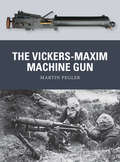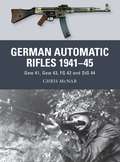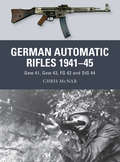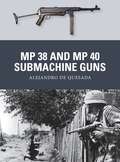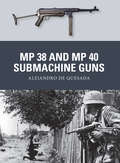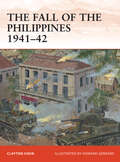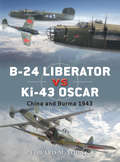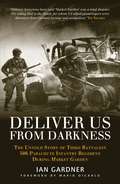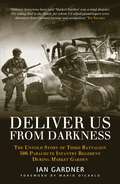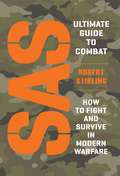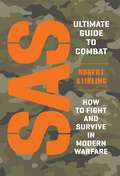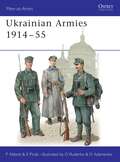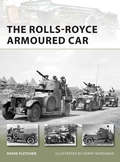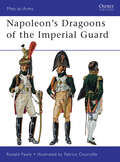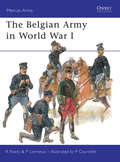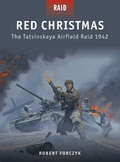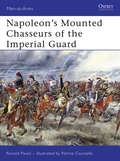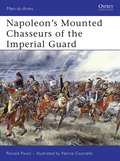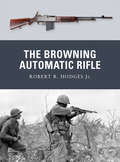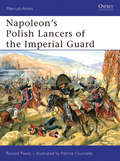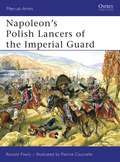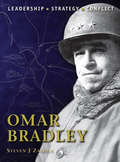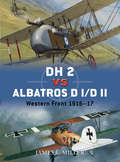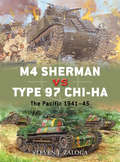- Table View
- List View
The Vickers-Maxim Machine Gun (Weapon #25)
by Peter Dennis Martin PeglerThe world's first self-powered machine gun, the Maxim gun became a potent symbol of Victorian colonialism in the closing years of the 19th century. It was the brainchild of Sir Hiram Maxim, the American-born firearms inventor who founded the company bearing his name with financing from Albert Vickers, who became the company's chairman; Maxim's company was absorbed by Vickers, Sons and Company in 1897. Subsequent variants in British, German and Russian service – the .303in Vickers (1912), 7.92mm MG 08 (1908) and 7.62mm PM M1910, respectively – dominated both the Eastern and Western Fronts during World War I and soldiered on into World War II, while the Vickers remained in front-line British service essentially unchanged until 1968. Featuring specially commissioned full-colour artwork and written by a noted authority, this is the engaging story of the Maxim and its descendants, the innovative rapid-fire weapons that saw combat with British, German, Russian and other forces in the late Victorian era and throughout the world wars.
German Automatic Rifles 1941–45: Gew 41, Gew 43, FG 42 and StG 44 (Weapon)
by Ramiro Bujeiro Chris McNab Alan GillilandThis book explores the origins, development, combat use and lasting influence of Nazi Germany's automatic rifles, focusing on the Gew 41(W), Gew 43/Kar 43, FG 42 and MP 43/StG 44. The Blitzkrieg campaigns of 1939–40 convinced many observers that most infantry combat took place at closer ranges than the 750–1,000m. From 1941 Germany's arms designers took note and produced a new series of infantry firearms. This study not only provides a detailed technical description of each weapon, but also explores how the firearms performed on the battlefields of World War II. The combat takes us from the FG 42 in the hands of Fallschirmjäger at Monte Cassino through to StG 44s being used by Waffen-SS soldiers on both the Eastern and Western Fronts. Postwar service is also studied, such as the Gew 43's adoption by the Czech Army and the StG 44's use by the Viet Cong in the Vietnam War. Setting each firearm in its tactical and historical context, and employing striking photographs and full-colour artwork, firearms expert Chris McNab sets out the absorbing story of this distinctive and influential series of weapons.
German Automatic Rifles 1941–45: Gew 41, Gew 43, FG 42 and StG 44 (Weapon #24)
by Ramiro Bujeiro Chris McNab Alan GillilandThis book explores the origins, development, combat use and lasting influence of Nazi Germany's automatic rifles, focusing on the Gew 41(W), Gew 43/Kar 43, FG 42 and MP 43/StG 44. The Blitzkrieg campaigns of 1939–40 convinced many observers that most infantry combat took place at closer ranges than the 750–1,000m. From 1941 Germany's arms designers took note and produced a new series of infantry firearms. This study not only provides a detailed technical description of each weapon, but also explores how the firearms performed on the battlefields of World War II. The combat takes us from the FG 42 in the hands of Fallschirmjäger at Monte Cassino through to StG 44s being used by Waffen-SS soldiers on both the Eastern and Western Fronts. Postwar service is also studied, such as the Gew 43's adoption by the Czech Army and the StG 44's use by the Viet Cong in the Vietnam War. Setting each firearm in its tactical and historical context, and employing striking photographs and full-colour artwork, firearms expert Chris McNab sets out the absorbing story of this distinctive and influential series of weapons.
MP 38 and MP 40 Submachine Guns (Weapon #31)
by Johnny Shumate Alejandro De Quesada Alan GillilandNazi Germany's MP 38 and MP 40 submachine guns are among World War II's most recognizable weapons. Portable and with folding stocks, both were widely issued to airborne troops and became the hallmark of Germany's infantry section and platoon leaders. A million were produced during the conflict – and many found their ways into the hands of paramilitary and irregular forces from Israel to Vietnam after the war. Featuring specially commissioned full-color artwork and period and close-up photographs, this is the story of the origins, combat use, and lasting influence of two of World War II's most famous firearms.
MP 38 and MP 40 Submachine Guns (Weapon #31)
by Johnny Shumate Alejandro De Quesada Alan GillilandNazi Germany's MP 38 and MP 40 submachine guns are among World War II's most recognizable weapons. Portable and with folding stocks, both were widely issued to airborne troops and became the hallmark of Germany's infantry section and platoon leaders. A million were produced during the conflict – and many found their ways into the hands of paramilitary and irregular forces from Israel to Vietnam after the war. Featuring specially commissioned full-color artwork and period and close-up photographs, this is the story of the origins, combat use, and lasting influence of two of World War II's most famous firearms.
The Fall of the Philippines 1941–42 (Campaign #243)
by Clayton K. ChunIn the immediate aftermath of Pearl Harbor, the Japanese launched an attack on the Philippines to eliminate the United States' other major Pacific naval base. Catching the US forces completely by surprise, the Japanese bombed the major airfields and quickly gained air supremacy. They followed with a full-scale invasion that quickly rolled up US–Filipino opposition and captured Manila. Meanwhile US forces, under the leadership of the Douglas MacArthur, created a series of defensive lines to try and stop the Japanese advance. Despite their efforts, they were continually pushed back until they held nothing more than the small island of Corregidor. With doom hanging over the US–Filipino forces, Douglas MacArthur was ordered to fly to safety in Australia, vowing to return. Nearly five months after the invasion began, the US–Filipino forces surrendered, and were led off on the 'Bataan Death March'. This book covers the full campaign from the planning through to the execution, looking at the various battles and strategies that were employed by both sides in the battle for the Philippines.
B-24 Liberator vs Ki-43 Oscar: China and Burma 1943 (Duel #41)
by Jim Laurier Gareth Hector Edward M. YoungIn reviewing reports of air combat from Spain, China and the early stages of the war in Europe, the US Army Air Corps called for heavier armor and armament for its bomber fleet, including the addition of a tail turret. While Japan tried to counter with their own heavy fighters, their inability to produce them in any number meant that they were forced to face the bomber threat with the nimble, but under–armed Ki-43 "Oscar†?. While severely outgunned, the Japanese learned to use their greater maneuverability to exploit the small weakness in bomber defenses. This book tells the story of the clash in the skies over the Pacific, as the Japanese fought desperately against the coming tide of the American bomber offensive.
Deliver Us From Darkness: The Untold Story of Third Battalion 506 Parachute Infantry Regiment during Market Garden
by Ian Gardner Mario DiCarlo Ed ShamesThis follow-up to Tonight We Die As Men continues the story of the 506 Parachute Infantry Regiment of the 101st Airborne Division as they dropped into Holland as part of Operation Market Garden. The following 72-day campaign saw the 506PIR constantly on the move, defending various transport hubs around Eindhoven, desperately trying to keep open 'Hell's Highway'. From there, the airborne troopers moved north to near Arnhem where they took a new position around Betuwe. For two months, the Americans battled against German tanks, constant artillery barrages and driving rain and they grimly held their ground, until the Germans finally abandoned the effort. Written with the help and input from numerous veterans, this book tells the complete story of many of America's best soldiers as they fought and died in Holland.
Deliver Us From Darkness: The Untold Story of Third Battalion 506 Parachute Infantry Regiment during Market Garden (General Military Ser.)
by Ian GardnerThis follow-up to Tonight We Die As Men continues the story of the 506 Parachute Infantry Regiment of the 101st Airborne Division as they dropped into Holland as part of Operation Market Garden. The following 72-day campaign saw the 506PIR constantly on the move, defending various transport hubs around Eindhoven, desperately trying to keep open 'Hell's Highway'. From there, the airborne troopers moved north to near Arnhem where they took a new position around Betuwe. For two months, the Americans battled against German tanks, constant artillery barrages and driving rain and they grimly held their ground, until the Germans finally abandoned the effort. Written with the help and input from numerous veterans, this book tells the complete story of many of America's best soldiers as they fought and died in Holland.
SAS Ultimate Guide to Combat: How to Fight and Survive in Modern Warfare
by Robert StirlingI've written this book to help you – the soldier – kill the enemy when you get the chance and, most importantly, come back home in one piece. To achieve this aim I've covered combat training from boot camp up to the level required of a Special Forces soldier. And then gone on to add a few tricks of my own. I've done a bit of soldiering (Northern Ireland, SAS deployments, Bush Wars in Africa, life as a merc) and been in my fair share of fire-fights. I've only been wounded twice and learnt from both occasions. I'm going to use my experience to teach you to play the game. I'm not going to teach you how to survive in snowy mountains for a month with only one tea-bag or how to kill a room fill of people with only a toothpick. There are plenty of books that do that already. This book will teach you how to fight and survive war in the 21st century from the tools of the trade, to avoiding getting shot or blown-up, from surviving an interrogation to defending a position. This is a book not for the faint hearted. But then neither is war.
SAS Ultimate Guide to Combat: How to Fight and Survive in Modern Warfare (General Military Ser.)
by Robert StirlingI've written this book to help you – the soldier – kill the enemy when you get the chance and, most importantly, come back home in one piece. To achieve this aim I've covered combat training from boot camp up to the level required of a Special Forces soldier. And then gone on to add a few tricks of my own. I've done a bit of soldiering (Northern Ireland, SAS deployments, Bush Wars in Africa, life as a merc) and been in my fair share of fire-fights. I've only been wounded twice and learnt from both occasions. I'm going to use my experience to teach you to play the game. I'm not going to teach you how to survive in snowy mountains for a month with only one tea-bag or how to kill a room fill of people with only a toothpick. There are plenty of books that do that already. This book will teach you how to fight and survive war in the 21st century from the tools of the trade, to avoiding getting shot or blown-up, from surviving an interrogation to defending a position. This is a book not for the faint hearted. But then neither is war.
Ukrainian Armies 1914–55 (Men-at-Arms #412)
by Peter Abbott Eugene PinakThere can be no region in Europe whose history has been more tortured than Ukraine. During the 20th century Austria, Poland, Russia, Germany, Hungary, Czechoslovakia and Romania vied for power over parts of this vast and fragmented area; and its divided peoples rose time and again in vain attempts to win their independence. For the first time in the West, this book gives a succinct summary of all the different armed forces raised among the Ukrainians, and of their uniforms and insignia. These are illustrated in colour and in a selection of extremely rare photographs, dating from the Great War to the aftermath of World War II, when Ukrainian guerrillas continued to defy the Soviet authorities until the mid-1950s.
The Rolls-Royce Armoured Car (New Vanguard #189)
by David Fletcher Mr Henry MorsheadThe first Rolls-Royce armoured car was a privately owned vehicle fitted with a machine-gun and a limited amount of armour plate, used by the Royal Naval Air Service in Flanders in 1914. By 1915, nearly 100 had been built and turned over to the Army. From then on, as Sir Albert Stern said 'They searched the world for war', operating as far apart as the northwest frontier of India, the Middle East and southern Africa. The cars were fast, quiet and reliable but above all powerful. 'A Rolls in the desert is above rubies,' said Lawrence of Arabia. After World War I, the War Office continued to produce the Rolls-Royce while tinkering with the design. These further cars served all across the Empire, including in Ireland and even later Shanghai, returning for a final brief appearance in the early stages of World War II.This book tells the complete story of the Rolls-Royce Armoured Car, following its design and development as it fought from theatre to theatre during World War I and the turbulent inter-war years.
Ukrainian Armies 1914–55 (Men-at-Arms)
by Peter Abbott Oleksiy Rudenko Eugene PinakThere can be no region in Europe whose history has been more tortured than Ukraine. During the 20th century Austria, Poland, Russia, Germany, Hungary, Czechoslovakia and Romania vied for power over parts of this vast and fragmented area; and its divided peoples rose time and again in vain attempts to win their independence. For the first time in the West, this book gives a succinct summary of all the different armed forces raised among the Ukrainians, and of their uniforms and insignia. These are illustrated in colour and in a selection of extremely rare photographs, dating from the Great War to the aftermath of World War II, when Ukrainian guerrillas continued to defy the Soviet authorities until the mid-1950s.
Napoleon’s Dragoons of the Imperial Guard (Men-at-Arms #480)
by Ronald PawlyDressed in distinctive green uniforms and classically inspired copper helmets, the Dragoons of the Imperial Guard were raised in 1806 by the same criteria as other Guard units – by selection of picked, literate veterans from Line regiments who had six to ten years of service, and citations for bravery in at least two campaigns. The following year they were named Dragons de l'Impératrice in a unique compliment to the Empress Josephine. As a ceremonial regiment it enjoyed many privileges, but it also saw combat on a number of occasions, including the battles of Essling and Wagram (1809), the Russian campaign (1812, when it suffered severe losses), at Bautzen, Wachau and Leipzig (1813), in the 1814 Campaign of France, and at Ligny and Waterloo (1815).
The Belgian Army in World War I (Men-at-Arms #452)
by Patrice Courcelle Ronald Pawly Pierre LierneuxWhile small in numbers, the Belgian Army played a vital role in World War 1 that is often overlooked. Germany's invasion of neutral Belgium, which led Britain to declare war in August 1914, should have been swift and fierce yet the unexpected heroic defence, against great odds, of Belgian fortresses, frustrated the German Schlieffen Plan for a thrust to Paris and a lightning victory. The plucky Belgian resistance proved successful in buying time for French and British troops to mobilize and report to the front, where the Belgians would then go on to fight, stubbornly defending the northern end of the Allied trench line for the rest of the war. Discover the story of this determined Army, from their organization and commanders, to their uniforms and equipment. The only main combatant army of World War I not previously covered by Osprey, this volume will be an important addition to any enthusiast's collection, accompanied by detailed artwork and archive photographs.
Red Christmas: The Tatsinskaya Airfield Raid 1942 (Raid #30)
by Robert ForczykBy December 1942, the Soviets had surrounded the German 6th Army in Stalingrad, cutting off all lines of supply except through the air. Seeking to sever this last German lifeline, Soviet Command decided to launch a raid with the entire 24th Tank Corps to seize the airfield at Tatsinskaya, the primary operating base for the German airlift efforts. On 17 December, the 24th Tank Corps advanced toward Tatsinskaya, seizing the airfield on Christmas Eve. The Soviet tankers succeeded in destroying many Luftwaffe aircraft on the ground, but afterwards found themselves isolated and out of fuel behind the German lines. Generalfeldmarschall Erich von Manstein rapidly organized a counterattack with elements of two panzer divisions, crushing most of the raiding force between 26 and 28 December. Just before the raiding force was annihilated, it received permission to abandon its heavy equipment and escape back to Soviet lines on foot. Thus, the raiders accomplished their mission of severely disrupting the airlift to Stalingrad, but at the cost of an entire tank corps.
Napoleon’s Mounted Chasseurs of the Imperial Guard (Men-at-Arms #444)
by Ronald PawlyA concise history of the hand-picked elite cavalry guard that served as Napoleon's close personal escort and were committed to the most dangerous areas of combat on the battlefield. Formed from his original escort of 'Guides' and the 'Consular Guard' in 1799, the Mounted Chasseurs were a personal favourite of the Emperor, who wore their uniform on campaign. Ronald Pawly's unique research into regimental archives has uncovered unprecedented detail about this exceptional unit and its soldiers and officers. With their colourful uniforms recreated in full-colour artwork and accounts of their actions in the most critical Napoleonic battles, this book provides a comprehensive description of these legendary elite soldiers.
Napoleon’s Mounted Chasseurs of the Imperial Guard (Men-at-Arms)
by Patrice Courcelle Ronald PawlyA concise history of the hand-picked elite cavalry guard that served as Napoleon's close personal escort and were committed to the most dangerous areas of combat on the battlefield. Formed from his original escort of 'Guides' and the 'Consular Guard' in 1799, the Mounted Chasseurs were a personal favourite of the Emperor, who wore their uniform on campaign. Ronald Pawly's unique research into regimental archives has uncovered unprecedented detail about this exceptional unit and its soldiers and officers. With their colourful uniforms recreated in full-colour artwork and accounts of their actions in the most critical Napoleonic battles, this book provides a comprehensive description of these legendary elite soldiers.
The Browning Automatic Rifle (Weapon #15)
by Johnny Shumate Alan Gilliland Robert R. Hodges Jr. Robert R. HodgesFor nearly fifty years the hard-hitting, mobile Browning Automatic Rifle, or BAR, served in US infantry units as a light squad automatic "base of fire†? weapon, providing quick bursts of concentrated fire. Designed in World War One, it didn't reach the front until September 1918. In the interwar years US forces used the BAR across the world, from China to Nicaragua. It also became a favorite of notorious gangsters like Clyde Barrow and Bonnie Parker, who prized its ability to punch through police armored cars. At the outset of World War II the US armed forces decided to adapt the BAR for a light machine gun role. The BAR was not without its flaws; it was heavy and difficult to dismantle and reassemble, and it didn't cope well with sustained fire. Nevertheless, the BAR saw action in every major theater of World War II and went on to be used in Korea and in the opening stages of the Vietnam War. Featuring arresting first-hand accounts, specially drawn full-color artwork and close-up photographs, many in color, this lively study offers a vivid portrait of this powerful, long-lived and innovative weapon that saw service with US and other forces across the world for much of the 20th century.
Napoleon’s Polish Lancers of the Imperial Guard (Men-at-Arms #440)
by Patrice Courcelle Ronald PawlyThis book draws on original regimental records to give by far the most detailed account ever published in English of the organization and personalities of the most renowned of the foreign units that served in the Emperor's armies. Unlike most of his foreign troops, these Polish horsemen were true volunteers, who owed their honoured place in his Imperial Guard to their proven courage and dash on battlefields from Spain to Russia. The text is illustrated with rare portraits and photographs, and with detailed colour plates of the Lancers' magnificent uniforms.
Napoleon’s Polish Lancers of the Imperial Guard (Men-at-Arms)
by Patrice Courcelle Ronald PawlyThis book draws on original regimental records to give by far the most detailed account ever published in English of the organization and personalities of the most renowned of the foreign units that served in the Emperor's armies. Unlike most of his foreign troops, these Polish horsemen were true volunteers, who owed their honoured place in his Imperial Guard to their proven courage and dash on battlefields from Spain to Russia. The text is illustrated with rare portraits and photographs, and with detailed colour plates of the Lancers' magnificent uniforms.
Omar Bradley (Command #25)
by Steven J. Zaloga Mr Steve NoonGeneral Omar Bradley was the premier US Army tactical commander in the European Theatre of Operations in 1944–45. A West Point classmate of Dwight Eisenhower, Bradley was the quintessential US field commander of World War II, elevated to high command with little combat experience but a solid track record as a skilled planner and organiser. Bradley was part of a small cadre of highly skilled young officers groomed for higher command in the austere and bankrupt 1930s. Bradley was at the centre of nearly all the major US Army victories in 1944–45 from D-Day through the final push into Germany. Along with that combat record came a string of controversies. Bradley's greatest blunder, failing to anticipate the German offensive in the Ardennes, was counter-balanced by a vigorous and skilled response which fatally injured the German Army in the West. Beyond the performance of the US Army in the ETO, Bradley was also intimately wrapped up in other controversies, especially the internecine squabbles with his British counterpart, Bernard Montgomery.
DH 2 vs Albatros D I/D II: Western Front 1916 (Duel #42)
by Jim Laurier Mr Mark Postlethwaite James F. MillerFlown by Victoria Cross recipient Lanoe Hawker and the members of No 24 Sqn, the ungainly yet nimble DH 2 helped the Allies attain air superiority over the Somme in early 1916 and hold it through the summer. With its rotary engine 'pusher' configuration affording excellent visibility and eliminating the need for a synchronized machine gun, the DH 2 was more than a match for anything the Germans could put in the air. That is, until the arrival of the Albatros D II, a sleek inline-engined machine built for speed and with twin-gun firepower. Thus, the later part of 1916 saw an epic struggle in the skies above the Somme pitting the manoeuvrable yet under-gunned DH 2s against the less nimble yet better armed and faster Albatros D IIs. In the end the Germans would regain air superiority, three squadron commanders – two of whom were considered pinnacles of their respective air forces – would lose their lives, and an up-and-coming pilot (Manfred von Richthofen) would triumph in a legendary dogfight and attain unimagined heights fighting with tactics learned from a fallen mentor.
M4 Sherman vs Type 97 Chi-Ha: The Pacific 1945 (Duel #43)
by Steven J. Zaloga Richard ChasemoreAlthough US and Japanese tank forces first clashed in 1941, it was on in 1944 that tank-vs-tank action became more common as both sides poured larger numbers of tanks into the combat zone. These battles were a means of demonstrating each side's latest tank technology. For the US, the pinnacle of their tank machinery came in the form of the M4 Sherman and for the Japanese, their most notable feat of engineering was the smaller, yet still effective Type 97 Chi-Ha. The last two campaigns of the war – Iwo Jima and Okinawa – saw tanks used by both sides, the Japanese finally concluding that "the fight against the US Army is a fight against his M4 tanks†?. The illustrations follow the usual Duel pattern with profile illustrations of the Type 97-kai Shinhoto Chi-ha and the M4A3, views showing the ammunition of both types, interior illustrations showing the turret layout in both types, and a battlescene showing the Type 97-kai in combat against US armour.
